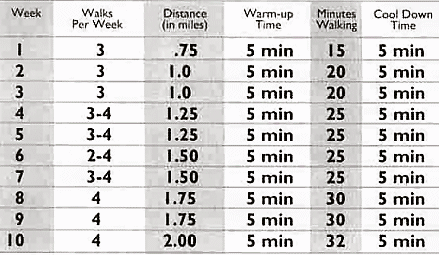 Walking is a gentle, low-impact exercise that can ease you into a higher level of fitness and health. Walking is a form of exercise accessible to just about everybody. It's safe, simple and doesn't require practice. And the health benefits are many.
Walking is a gentle, low-impact exercise that can ease you into a higher level of fitness and health. Walking is a form of exercise accessible to just about everybody. It's safe, simple and doesn't require practice. And the health benefits are many.
The Benefits of Walking
Walking, like other exercise, can help you achieve a number of important health benefits.
Walking can help you:
• Lower low-density lipoprotein (LDL) cholesterol (the "bad" cholesterol)
• Raise high-density lipoprotein (HDL) cholesterol (the "good" cholesterol)
• Lower your blood pressure
• Reduce your risk of or manage type 2 diabetes
• Manage your weight
• Improve your mood
• Stay strong and fit
All it takes to reap these benefits is a routine of brisk walking. It doesn't get much simpler than that. And you can forget the "no pain, no gain" talk. Research shows that regular, brisk walking can reduce the risk of heart attack by the same amount as more vigorous exercise, such as jogging.
So, how should you start your walking program?
Frequency: Aim for a minimum of 3 days a week, and gradually work your way up to 5 or 6 days a week. The more the better--especially when it comes to weight loss. But don't forget the importance of rest and recovery--give yourself at least 1-2 days off each week.
TAKE A LOOK: Here's How To Burn More Fat Just By Walking
Intensity: You can use your target heart rate range or the "Talk Test" to make sure you're working out in a good range (not too easy, not too hard). If you can comfortably answer a question during exercise, while still feeling like you're exerting yourself, you're in a good calorie-burning range. This range is ideal for the general health benefits that come with exercise, and for weight loss.
Time: The recommended time for most people ranges from a minimum of 20 minutes (for simple general health), all the way up to about 60 minutes. Of course, it's smart to work your way up gradually. A good gauge to begin to physically see weight loss is 45 minutes. Try doing 45 minutes of walking at a moderate "talking" pace for 5-6 days a week. Once you're able to do that with no issues for about 4 weeks, then you can ramp up the intensity, not the time.
The further you go over 20 minutes, the more fat you are burning, so that can be a good motivator.
Here's a sample walking workout for you to try:

Things to keep in mind:
• Time can be cumulative: You don't have to do 60 minutes all at once. You can do several 5-10 minute mini-workouts each day and add them up.
• If you can't reach your target heart rate with walking, then add intensity by increasing speed or incline.









